ASM Metals HandBook Vol. 17 - Nondestructive Evaluation and Quality Control
Подождите немного. Документ загружается.

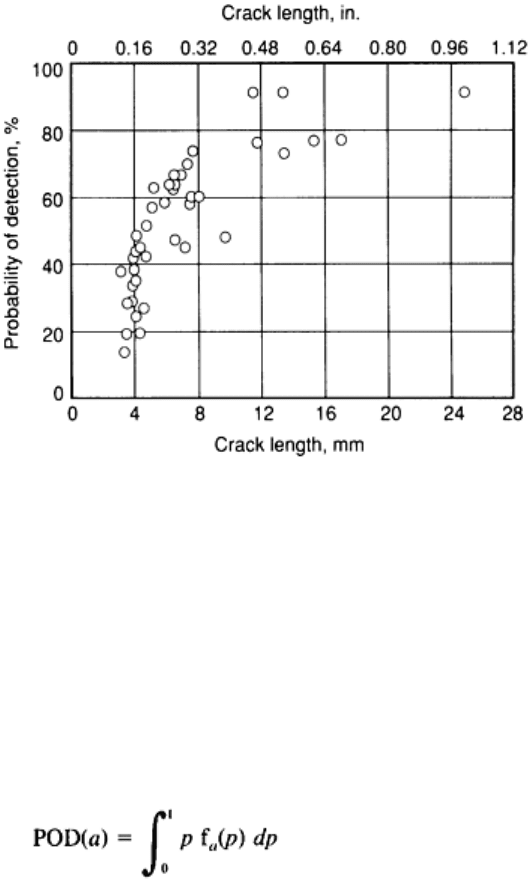
Fig. 1 Example crack detection probabilities from 60 eddy current inspections of each crack
The POD(a) function is defined as the proportion of all cracks of size a that will be detected in a particular application of
an NDE system. Assume that each crack of size a in the potential population of cracks has its own distinct crack detection
probability, p, and that the probability density function of the detection probabilities is given by f
a
(p). Figure 2 shows a
schematic representation of this density. The conditional probability of a randomly selected crack from the population
having detection probability of p and being detected at the inspection is given by p f
a
(p) dp. The unconditional probability
of a randomly selected crack from the population being detected is the sum of the conditional probabilities over the range
of p, that is:
(Eq 1)
Therefore, POD(a) is the average of the detection probabilities for cracks of size a.
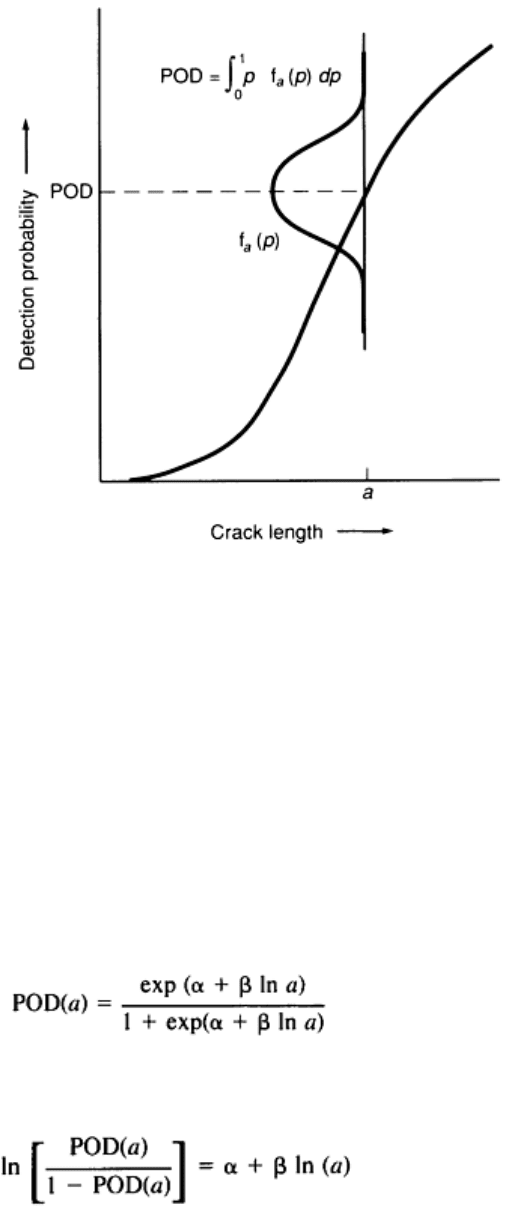
Fig. 2
Schematic of distribution of detection probabilities for cracks of fixed
length
Equation 1 implies that the POD(a) function is the curve through the averages of the individual density functions of the
detection probabilities. This curve is the regression equation and provides the basis for testing assumptions about the
applicability of various POD(a) models. In Ref 4, seven different functional forms were tested for applicability to
available POD data, and it was concluded that the log-logistics (log odds) function best modeled the data and provided an
acceptable model for the data sets of the study. Note that the log odds model is commonly used in the analysis of binary
(hit/miss) data because of its analytical tractability and its close agreement with the cumulative log normal distribution
(Ref 8).
Two mathematically equivalent forms of the log odds model have subsequently been used. The earliest form is given by:
(Eq 2)
This parametrization can also be expressed as:
(Eq 3)
In the Eq 3 form, the log of the odds of the probability of detection (the left-hand side of Eq 3) is expressed as a linear
function of ln (a) and is the source of the name of the log odds model. Note that given the results of a large number of
independent inspections of a large number of cracks, the parameters of the model can be fit with a regression analysis. As
an example, Fig. 3 shows Eq 3 fit to the data of Fig. 1. This regression approach will not be discussed further, because the
maximum likelihood estimates (see the section "Analysis of Hit/Miss Data" in this article) can be applied to much smaller
samples of inspection results and can give equivalent answers for large sample sizes.
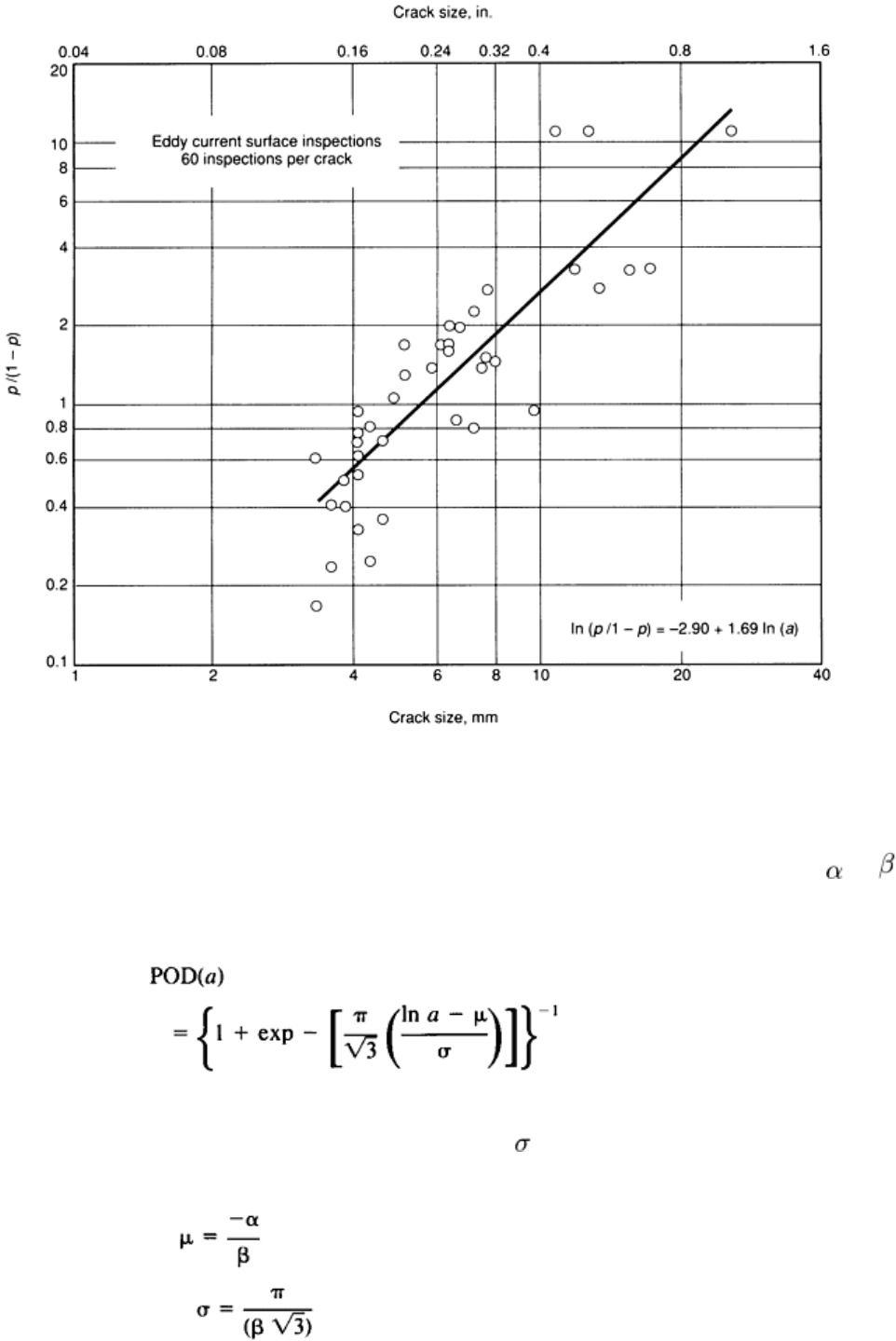
Fig. 3 Example linear relation between log odds of crack detection and log crack size
Although the parametrizations of Eq 2 and 3 are sensible in terms of estimation through regression analyses, and are
not easily interpretable in physical terms. A mathematically equivalent form of the log odds POD(a) model is given by
(Ref 8):
(Eq 4)
In this form, μ= ln a
0.5
, where a
0.5
is the flaw size that is detected 50% of the time, that is, the median detectable crack
size. The steepness of the POD(a) function is inversely proportional to ; that is, the smaller the value of σ, the steeper
the POD(a) function. The parameters of Eq 2 and 4 are related by:
(Eq 5)
(Eq 6)
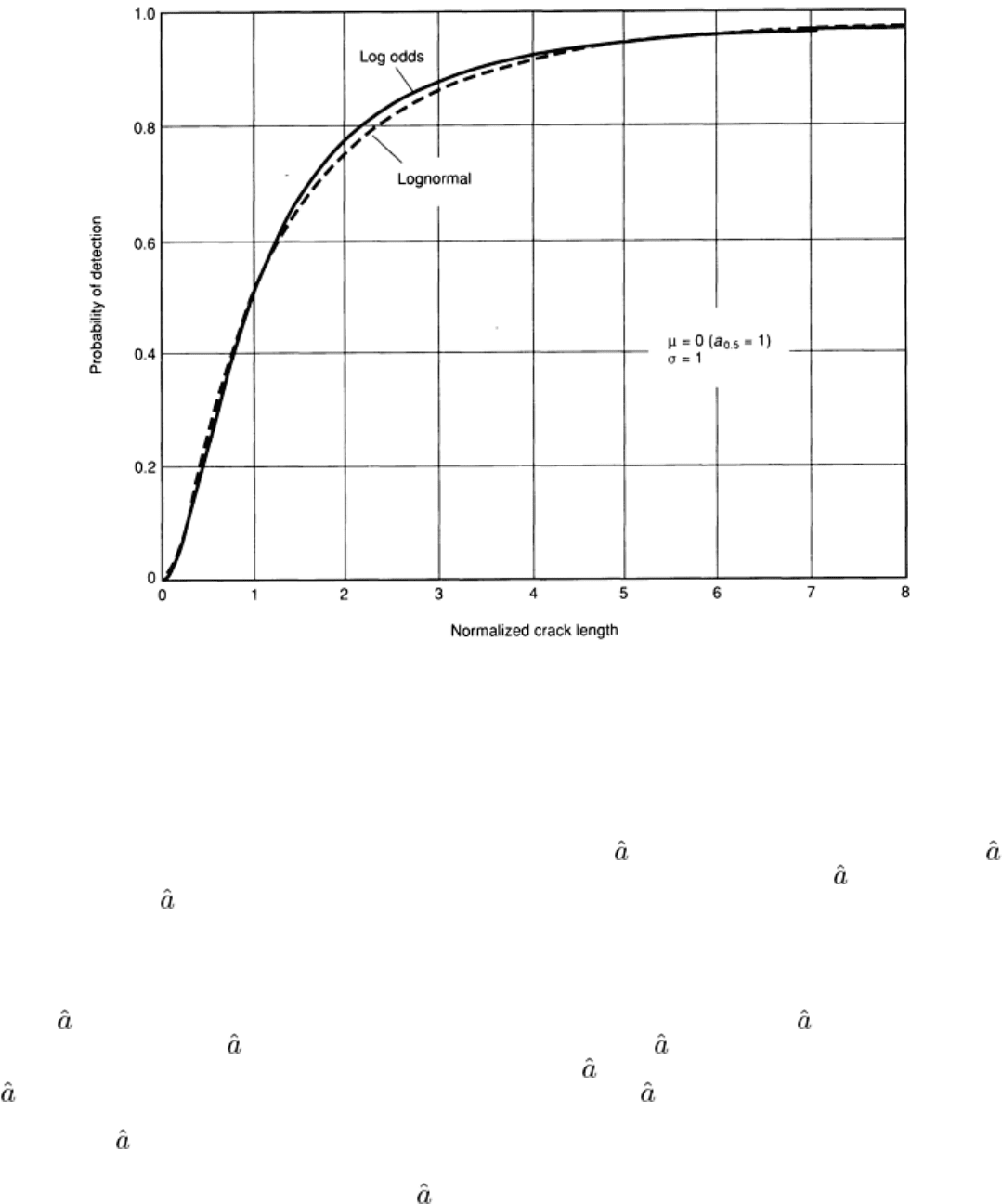
The log odds POD(a) function is practically equivalent to a cumulative log normal distribution with the same parameters,
μ and σ of Eq 4. Figure 4 compares the log odds and cumulative log normal distribution functions for μ= 0 and σ= 1.
Equation 4 is the form of the log odds model that will be used in the section "Analysis of Hit/Miss Data" in this article.
Fig. 4 Comparison of log odds and cumulative log normal models
POD(a) From Signal Response Data. The NDE flaw indications are based on interpreting the response to a
stimulus. In eddy current or ultrasonic systems, the response might be a peak voltage referenced to a calibration. In
fluorescent penetrant inspections, the response would be a combination of brightness and size of the indication. Assume
the response can be quantified and recorded in terms of a parameter, , that is correlated with flaw size. Then
summarizes the information for determining if a positive flaw indication will be given. Only if exceeds a defined
decision threshold,
dec
, will a positive indication be given.
As an example of the concept, Table 2 summarizes the results of highly automated eddy current inspections of 28 cracks
in flat plate specimens. The three data sets resulted from the use of three probes, with all other factors held constant. The
values in Table 2 are the depth of each crack and the peak voltage in counts recorded by the system. Figure 5 shows a plot
of the versus a data for probe A. No signal was recorded for 2 of the cracks, because their values were below the
recording signal threshold,
th
. These points are indicated by a down arrow at
th
, indicating that the response was at an
indeterminable value below the recording signal threshold. Similarly, for 5 of the cracks exceeded the saturation limit,
sat
, of the recording system. These points are indicated by an up arrow at
sat
, indicating that the response was at an
indeterminable value above the recording saturation limit. In Fig. 5, the decision threshold is set at 250 counts. Only those
cracks whose value is above 250 would have been flagged (detected).
Table 2 Example of a summary data sheet of versus a data
The example is based on eddy current inspections of flat plates.

Crack depth
Peak voltage in counts
Crack identification
mm
in. Probe A
Probe B
Probe C
11 0.33
0.013
1052 884
1282
30 1.40
0.055
4095 4095
3831
42 0.38
0.015
1480 1182
1699
2 0.25
0.010
723 624
840
21 0.74
0.029
4095 4095
2249
13 0.48
0.019
2621 2401
1101
19 0.30
0.012
377 809
350
26 0.23
0.009
223 205
277
15 0.56
0.022
1654 3319
1289
29 1.65
0.065
4095 4095
2648
33 0.08
0.003
(a)
(a)
(a)
25 0.25
0.010
669 565
824
32 0.18
0.007
374 379
407
34 0.03
0.001
(a)
(a)
(a)
39 0.18
0.007
409 387
586
12 0.28
0.011
895 690
677
38 0.20
0.008
374 301
549
20 0.79
0.031
4095 4095
1778
28 0.23
0.009
638 454
782

27 0.15
0.006
533 385
631
1 0.08
0.003
150 136
135
35 0.28
0.011
749 660
989
40 0.20
0.008
433 378
591
31 0.36
0.014
879 888
1402
3 0.23
0.009
286 211
352
7 0.23
0.009
298 163
215
16 0.41
0.016
1171 1110
1628
37 2.54
0.100
4095 4095 4095
(a)
Peak voltage below the recording level threshold

Fig. 5 Example inspection signal response as a function of crack depth
The POD(a) function can be obtained from the relation between and a. If g
a
( ) represents the probability density of the
values for fixed crack size a, then:
(Eq 7)
This calculation is illustrated in Fig. 6, in which the shaded area under the density functions represents the probability of
detection.

Fig. 6 Schematic of POD(a) calculation from versus a relation
In general, the correlating function between and a defines the mean of g
a
( ), that is:
= (a) +
(Eq 8)
where (a) is the mean of g
a
( ) and is a random error term accounting for the differences between and (a). The
distributional properties of δ determine the probability density g
a
( ) about μ (a), as will be shown.
In the data analyzed to date, a linear relation between ln ( ) and ln (a) with normally distributed deviations has proved
satisfactory (for example, Fig. 5). This model is expressed by:
ln ( ) =
0
+
1
ln (a) +
(Eq 9)
where δ is normally distributed with zero mean and constant standard deviation, . Data have been observed that flatten
at the large crack sizes. However, because the decision threshold was far below the non-linear range, restricting the range
of cracks to smaller sizes permitted the application of Eq 9. The normality of has proved to be an acceptable
assumption.
Assuming that the versus a relation is modeled by Eq 9 and that is normally distributed with zero mean and standard
deviation of , the POD(a) function is calculated as:
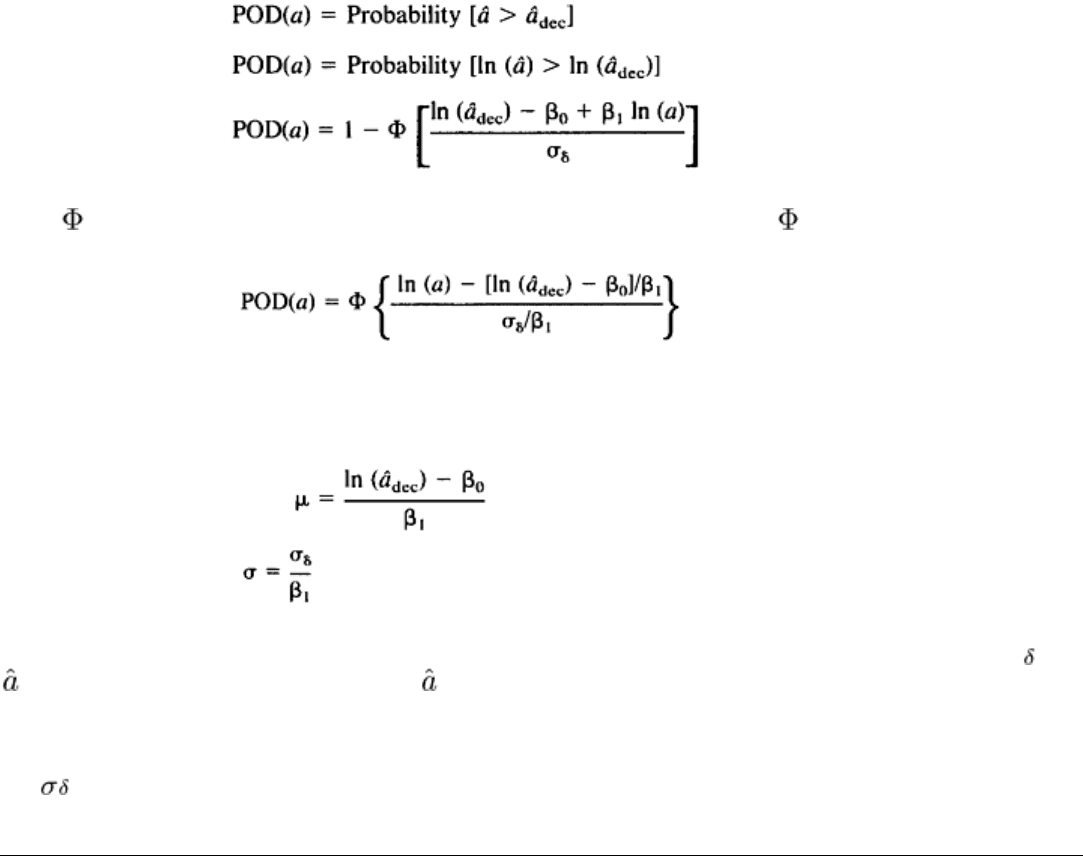
(Eq 10)
where is the standard normal distribution function. Using the symmetry properties of , Eq 10 can be reduced to:
(Eq 11)
Equation 11 is a cumulative log normal distribution function with mean and standard deviation of log crack length given
by:
(Eq 12)
(Eq 13)
In the section "Signal Response Analysis" in this article, maximum likelihood methods for estimating β
0
, β
1
, and σ from
versus a data will be presented. Note that the values below the recording threshold and above the saturation limit must
be properly accounted for in these analyses. Note also that data from multiple inspections of the same cracks require
analysis methods that are dependent on the design of the reliability experiment. Methods for placing lower confidence
bounds on the estimated POD(a) function using the sampling distributions of the maximum likelihood estimates of β
0
, β
1
,
and are also included in the section "Signal Response Analysis."
References cited in this section
3.
W.H. Lewis, W.H. Sproat, B.D. Dodd, and J.M. Hamilton, "Reliability of Nondestructive Inspections--
Final
Report," SA-ALC/MME 76-6-38-1, San Antonio Air Logistics Center, Kelly Air Force Base, Dec 1978
4.
A.P. Berens and P.W. Hovey, "Evaluation of NDE Reliability Characterization," AFWAL-TR-81-
4160, Vol
1, Air Force Wright-Aeronautical Laboratories, Wright-Patterson Air Force Base, Dec 1981
5.
A.P. Berens and P.W. Hovey, Statistical Methods for Estimating Crack Detection Probabili
ties, in
Probabilistic Fracture Mechanics and Fatigue Methods: Applications for Structural Design and
Maintenance,
STP 798, J.M. Bloom and J.C. Ekvall, Ed., American Society for Testing and Materials, 1983,
p 79-94
6.
D.E. Allison et al., "Cost/Risk Analysis for Disk Retirement--Volume I," AFWAL-TR-83-
4089, Air Force
Wright-Aeronautical Laboratories, Wright-Patterson Air Force Base, Feb 1984
7.
A.P. Berens and P.W. Hovey, "Flaw Detection Reliability Criteria, Volume I--
Methods and Results,"
AFWAL-TR-84-4022, Air Force Wright-Aeronautical Laboratories, Wright-
Patterson Air Force Base, April
1984
8.
D.R. Cox, The Analysis of Binary Data, Methuen and Co., 1970

NDE Reliability Data Analysis
Alan P. Berens, University of Dayton Research Institute
Design of NDE Reliability Experiments
An NDE reliability experiment comprises a test matrix of inspections on a set of specimens with known flaw locations
and sizes. The specimens are inspected under conditions that simulate as closely as practical the actual application
conditions. The experimental design determines the test matrix, and there are four major analysis concerns to be
addressed in the experimental design. These are:
• The method of controlling the factors to be evaluated in the experiment
• The method of accounting for the uncontrolled factors in the experiment
• The number of flawed and unflawed inspection sites
• The sizes of the flaws in the specimens
These topics are addressed in the following sections.
Controlled and Uncontrolled Factors
The primary objective of NDE reliability experiments has been to demonstrate efficacy for a particular application by
estimating the POD(a) function and its lower 95% confidence bound. (Although NDE reliability experiments can also be
conducted to optimize a system, analyses to meet this objective are beyond the scope of this article.) To demonstrate
capability, it is assumed that the protocol for conducting the inspections is well defined for the application, that the
inspection process is under control (hit/miss decisions are stable over time), and that all other factors introducing
variability into the inspection decision will be representative of the application. The representativeness of these other
factors can be ensured either by controlling the factors during the inspection or randomly sampling the factors to be used
in the experiment. The methods of accounting for these factors are important aspects of the statistical design of the
experiment and significantly influence the statistical properties of the estimates of the POD(a) function parameters. Of
particular note in this regard is that k inspections on n flaws is not equivalent to inspections on n · k different flaws, even
if the inspections are totally independent.
The most important of the factors introducing variation are:
• Differences in physical properties of cracks of nominally identical sizes
•
The basic repeatability of the magnitude of the NDE signal response when a specific crack is
independently inspected by a single inspector using the same equipment
•
The summation of all the human factors associated with the particular inspectors in the population of
interest
• Differences introduced by changes in inspection hardware
These factors must be addressed explicitly or implicitly in every NDE reliability experiment.
In general, the specimens used in NDE reliability experiments are very expensive to obtain and characterize in terms of
the sizes of the flaws in the specimens. Therefore, each experiment is based on one set of specimens containing flawed
and unflawed inspection sites. Because the results are significantly influenced by the specimens, it must be assumed that
the flaws are representative of those that will be present in the structural application. If other factors are to be included in
the experiment, they will be based on repeated inspections of the same flaws. From a statistical viewpoint, this restriction
on the experimental design limits the sample size to the number of flaws in the specimen set. Because different cracks of
the same size can have significantly different crack detection probabilities, multiple inspections of the same crack provide
information about the detection probability of only that crack.
